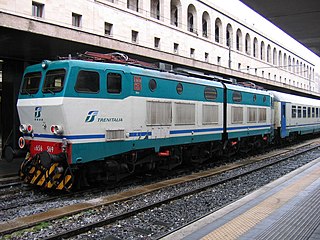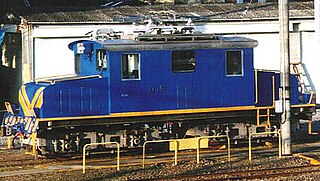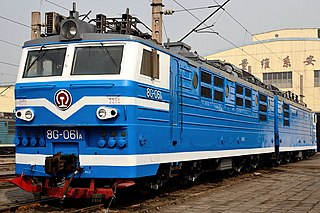
A Bo-Bo-Bo or Bo′Bo′Bo′ is a locomotive with three independent two-axle bogies with all axles powered by separate traction motors. In the AAR system, this is simplified to B-B-B due to the system only taking powered axles into consideration, not traction axles.

The British Rail Class D3/6 were diesel shunters designed in 1934/5 by English Electric for the London, Midland and Scottish Railway. (LMS)

Co-Co is the wheel arrangement for diesel and electric locomotives with two six-wheeled bogies with all axles powered, with a separate traction motor per axle. The equivalent UIC classification (Europe) for this arrangement is Co′Co′, or C-C for AAR.
B-B and Bo-Bo are the Association of American Railroads (AAR) and British classifications of wheel arrangement for railway locomotives with four axles in two individual bogies. They are equivalent to the B′B′ and Bo′Bo′ classifications in the UIC system. The arrangement of two, two-axled, bogies is a common wheel arrangement for modern electric and diesel locomotives.

The Class ED60 (ED60形) was a DC electric locomotive operated by Japanese National Railways (JNR) between 1958 and 1986. It was the first "second-generation" DC electric locomotive type featuring increased-power traction motors. Despite its diminutive size, the Bo-Bo wheel arrangement ED60 design offered performance comparable with the much larger Class EF15 1Co+Co1 design weighing almost twice as much.

The Shaoshan 7 is a type of electric locomotive used on the People's Republic of China's national railway system. They are widely used on electrified lines in the southwest part of China.

The Class EF62 (EF62形) is a Co′Co′ wheel arrangement DC electric locomotive type built between 1962 and 1969 for use hauling passenger and freight on the Shinetsu Main Line and particularly over the extreme 66.7‰, (6.67%), gradient of the Usui Pass between Yokokawa and Karuizawa. The prototype, EF62 1, was built by Kawasaki Sharyō in 1962, with the full-production locomotives built by Kawasaki, Tōshiba, and Tōyō & Kisha delivered from 1963 onward.

The Class DF50 (DF50形) is a class of Bo-Bo-Bo wheel arrangement diesel-electric locomotives operated by Japanese National Railways (JNR) in Japan from 1957 until 1983.

The Class EF500 (EF500形) was a prototype Bo-Bo-Bo wheel arrangement multi-voltage AC/DC electric locomotive formerly operated by JR Freight in Japan.

The Meitetsu DeKi 300 is a Bo-Bo wheel arrangement electric locomotive type operated by private railway operator Nagoya Railroad (Meitetsu) in Japan. The locomotives were used primarily on track maintenance trains, but following their withdrawal in 2014, only one locomotive, DeKi 303, remains in use, limited to depot shunting duties at Meitetsu's Maigi Maintenance Depot.

The Class ED10 (ED10形) was a Bo-Bo wheel arrangement electric locomotive that operated in Japan from 1922.

The Class ED75 (ED75形) is a Bo-Bo wheel arrangement AC electric locomotive type operated on passenger and freight services in Japan since 1963. A total of 302 locomotives were built by Hitachi, Mitsubishi, and Toshiba between 1963 and 1976. As of 1 April 2016, just five locomotives remained in service, all operated by JR East.

The Class ED73 (ED73形) was a Bo-Bo wheel arrangement AC electric locomotive type operated by Japanese National Railways (JNR) in Kyushu, Japan, between 1962 and the 1980s.

The Class EF70 (EF70形) is a Bo-Bo-Bo wheel arrangement AC electric locomotive type operated by Japanese National Railways (JNR) in Japan from 1961 until the 1980s. 81 locomotives were built by Hitachi and Mitsubishi between 1961 and 1965.

The 8G is a Soviet-built electric locomotive used in China. It is developed and built by Novocherkassk Electric Locomotive Plant. The design of 8G is based on Soviet Railway VL80S electric locomotives. It is a kind of locomotive with Bo′Bo′+Bo′Bo′ wheel arrangement used in China.

The 8K is a French-built electric locomotive used in China. It is developed and built by Alstom. The design of 8K is based on SNCF Class BB 15000 electric locomotives. It is a kind of locomotives with Bo′Bo′+Bo′Bo′ wheel arrangement used in China.

The Shaoshan 6 is a type of electric locomotive used on the People's Republic of China's national railway system. This locomotive was the sixth Chinese electric main line locomotive, built by the Zhuzhou Electric Locomotive Works.

The Pashishi class (パシシ) locomotives were a group of steam tender locomotives of the Chosen Government Railway (Sentetsu) with 4-6-2 wheel arrangement. The "Pashi" name came from the American naming system for steam locomotives, under which locomotives with 4-6-2 wheel arrangement were called "Pacific".

The Indian locomotive class WAM- 2/3 was a class of 25 kV AC electric locomotives that was imported from Japan in the 1960s for Indian Railways. The model name stands for broad gauge (W), AC Current (A), Mixed traffic (M) locomotive, 2nd generation (2). A total of 38 WAM-2/3 locomotives were built by The Japanese Group between 1960 and 1964. They entered service in 1960.

The Indian locomotive class WAG-2 was a class of 25 kV AC electric locomotives that was imported from Japan in the 1960s for Indian Railways. The model name stands for broad gauge (W), AC Current (A), Goods traffic (G) locomotive, 2nd generation (2). A total of 45 WAG-2 were built by The Japanese Group between 1964 and 1965. They entered service in 1964.
This page is based on this
Wikipedia article Text is available under the
CC BY-SA 4.0 license; additional terms may apply.
Images, videos and audio are available under their respective licenses.




















